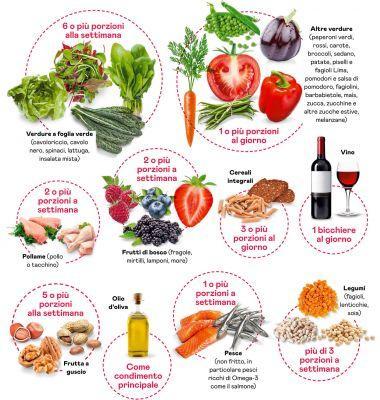
At first glance, nutrition and psychiatry have nothing in common. But the opposite is true: in the introduction to her book The diet of the brain (Rizzoli), the doctor a naidoo it helps us to understand how much nutrition can influence brain mechanisms, and consequently our well-being. The scholar is a true pioneer of nutritional psychiatry. She teaches at Harvard University Medical School, works at Massachusetts General Hospital and is also a professional chef (she graduated from Cambridge school of culinary art).
For Uma Naidoo, what we bring to the table can become a valuable drug to cure even our psychological ailments, especially in this moment of great emotional fatigue. One of the most common effects of the ongoing pandemic (and confinement) is the lack of concentration and the slowing of our cognitive abilities, first and foremost the memory. The food path that the expert offers us here, the Mind diet, wants to remedy this "tarnish".
A correct diet affects all types of memory
"It is important to know that a correct diet can enhance all memory abilities," explains Uma Naidoo.
“There is in fact one procedural memory which helps us learn new skills, such as playing the piano. Then there is the relational one, which allows us to remember facts and information, such as the latest news we read in the newspaper. There working memory instead it is the so-called “short-term”: we need to remember a phone number that has just been dictated to us or directions to reach a place we have never been to », continues the expert.
Choosing the right foods will improve all of these important functions in one fell swoop.
The effects of poor nutrition on our brain
At the same time, it is necessary to stay away from the "enemy" foods of the brain.
"THE high-fat foods (red meat and fried) and ad high glycemic index (white bread, white rice, potatoes, pasta and all refined flour products) can alter the brain pathways related to learning and memory, in particular the neurons of the hippocampus and the prefrontal cortex. The hippocampus is the part of the brain most involved in the formation of relational memories and its dimensions change the more memory is exercised. London taxi drivers, for example, have particularly developed it. A diet high in fats and sugars compromise its functions and reduce its size », warns the expert.
«Not only that: this area is also capable of regulate the amount of food we introduce. If it gets damaged, it goes haywire and we can't adjust to portions anymore. Furthermore, the latest research tells us that a high intake of saturated fat increases oxidative stress, which damages brain cells and can interfere with the role played by insulin in the hippocampus, compromising its efficiency ”, continues Uma Naidoo.
What is the Mind diet and how does it work
«The food path I talk about in the book, Mind, is the acronym for Mediterranean-Intervention for neurodegenerative delay.
It is a combination of two diets developed by Martha Morris and her team of researchers at Rush University in Chicago as early as 2015, whose goal is to improve brain health in the long run. Expects a number of food groups or individual useful foods (vegetables, nuts, berries, legumes, whole grains, fish, poultry, extra virgin olive oil and wine) and five harmful groups (red meat, butter and margarine, cheeses, sweets, fried and fast food) . And then there are the spices,, which play a valuable role in protecting our brain activities ”.
The power of microgreens
These are micro-vegetables: that is, vegetables that are harvested shortly after being sprouted. They are a valid alternative to classic leafy vegetables and, above all, they are a mine of nutrients; in fact, they contain 40 times more than their ripe counterparts, in particular vitamins such as C, E and K.
These miniature plants can be obtained from the leaves of many plants, including some really unsuspecting ones, such as for example radishes and sunflowers. Among the most popular vegetables there are also the microgreens derived from the leaves of coriander, the red cabbage, the kale and basil. Another great advantage of this mini garden is that it can be home grown: you need a shallow pot in which you will put a couple of centimeters of soil and its seeds (which you can buy at the nursery or online). Sow and wait for the sprouts to emerge: after two weeks, you can consume them by adding them to your favorite salads.
The weekly pattern that improves brain health
Here are the foods that are useful in a diet for the brain. They serve to improve brain health in the long run. Essential foods are vegetables, nuts and whole grains. Red wine is also precious but no more than 1 glass per day.
6 or more servings per week green leafy vegetables (kale, kale, spinach, lettuce, mixed salad)
1 or more servings per day other vegetables (green, red peppers, carrots, broccoli, celery, potatoes, peas and lima beans, tomatoes and tomato sauce, green beans, beets, corn, squash, courgettes and other summer squash, eggplant).
3 or more servings per day of whole grains
5 or more servings per week of nuts
More than 3 servings per week of legumes (beans, lentils, soy)
2 or more servings per week poultry (chicken or turkey)
2 or more servings per week of berries (strawberries, blueberries, raspberries, blackberries)
1 or more servings per week fish (not fried, especially Omega-3 rich fish such as salmon)
1 glass a day of wine
As a main seasoning olive oil

A smoothie to try: the snack that recharges the brain
Ingredients for one person
• 240 milliliters of almond milk unsweetened
• 7,5 grams of nights
• 1 measuring spoon of whey protein vanilla-flavoured
• 1 tablespoon of ground flax seeds
• 1 teaspoon of organic soluble coffee in powder
• 1 teaspoon of natural cocoa powder
• 1 tablespoon of coconut flakes
• ½ teaspoon of honey
• ½ of ripe avocado
Preparation: 10 minutes
Put all the ingredients in a blender with ¼ cup of ice cubes and blend. If so Smoothie it's too thick for your taste, add water or ice.
READ ALSO: Foods for memory and the brain: 6 neuron-friendly spices


























